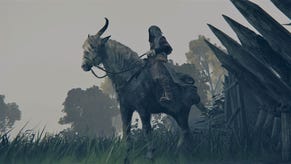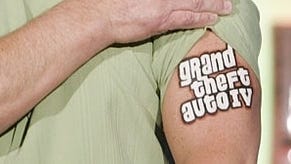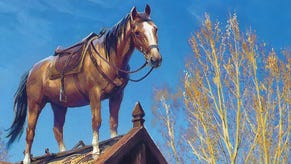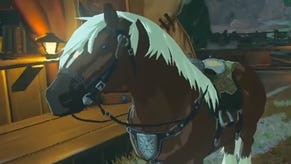The Legend of Zelda: Twilight Princess
Deserves a spotlight.
Kristan's take
Like many desirable things in life, it's not the size, it's what you do with it that counts. After so many years in development, we all expected the new Zelda to be an absolute monster of a game. Sure enough, Nintendo proudly proclaims on the back of the box that Twilight Princess is "the biggest Zelda adventure of all time".
It's no idle boast - but is that enough of a selling point on its own? Zelda games are usually of such inspirational quality you don't even need a review. You've already made your mind up, right? You pre-ordered it months ago and will spend the entire weekend nailed to your sofa. Sleep isn't even on the menu.
But what about the floating voters out there? The millions of PlayStation faithful and Xbox devotees who've never bothered buying a Nintendo home system, but have a DS and like the idea of the Wii. What about those of you who keep hearing about how good the Zelda games are, but fear the 50, 60 hours of hard slog required to get through it? It's a fair point. We've said it many times: we'd rather play a consistently entertaining eight to ten-hour game than a sprawling 60-hour epic that's an endlessly padded-out slog.
Thinking big
Thankfully, Twilight Princess fires a bomb arrow at that theory. Sure, it's a massive game. A behemoth. Even if you rush through it and never get stuck, it's easily four to five times the size of most mainstream games currently topping the charts, and comes as a bit of a shock to the system as a result. Every time you think you're 'nearly finished', a whole new portion of the game reveals itself, but does so in such a way that you never feel exhausted or overwhelmed by the task at hand. Chances are, you'll have had such a great time that you'll only ever be grateful to Nintendo for not only packing in so much gameplay, but making it so consistent all the way through.

But Twilight Princess isn't simply consistent. Consistency can get boring if you're just slogging through doing the same thing over and over - no matter how good that piece of entertainment is. The real delight about the latest addition to the Zelda series is how skilfully the game's been broken down into delicious chunks - like discreet episodes that unfold, embellish the storyline, increase your abilities and keep twisting the gameplay into new shapes that make the progression exciting and enticing. There's always an incentive to keep going. There are always new things to discover.
On so many levels that matter Twilight Princess is an absolute masterpiece. No wonder it took so long to make.
In terms of where it fits into the Zelda lineage, we're very much back in Ocarina of Time territory, and, for many, Twilight Princess will represent a spiritual sequel that's completely faithful to what fans expect from the series. In many ways, its determination to stay true to the legacy of the past holds it back to a degree, but we'll come back to that.
Link to the past

At the start, Twilight Princess stays true to the principle of young-unassuming -boy-saves-world -from-destruction, but manages to stick to the familiar Zelda formula without ever being tired or too predictable. To summarise, the Kingdom of Hyrule is suddenly shrouded in darkness, leaving the shocked population little more than confused spirits that cower from the monsters that glower in the twilight. After a fairly innocuous goat-herding, horse-riding introduction, Link finds himself caught up in the chaos, transformed into a Wolf and locked in a dungeon. But a kindly big-headed, small bodied shadow dweller called Midna helps you escape, and from then on you embark on a epic quest to free the land from the cursed twilight that infects the kingdom.
For a large chunk of the game Link's on an elaborate clean-up mission, freeing each section of the game world from the darkness that enslaves its people. Doing this follows a familiar pattern each time, ensuring you switch back and forth from your Wolf form and back again whenever you encounter a new section of the twilight-ravaged kingdom.
The first major section of each 'clean-up' process tasks you with collecting all the 'Tears of Light', which take the form of invisible dark insects that lurk in the darkest corners. Seeking them out involves switching into the wolf's 'sense' mode, which is effectively like a sort of night vision that enables you to detect things otherwise invisible to the naked eye - like scent and places you can dig down into. Acting as a subtle introduction to the plight of the characters that inhabit these darkened alternate dimensions, they can't see you, but switching to sense mode lets you listen to their fearful mutterings - once you've rounded up all the tears, light returns to the land and the characters give further information on what else is going wrong nearby.
Might as well jump
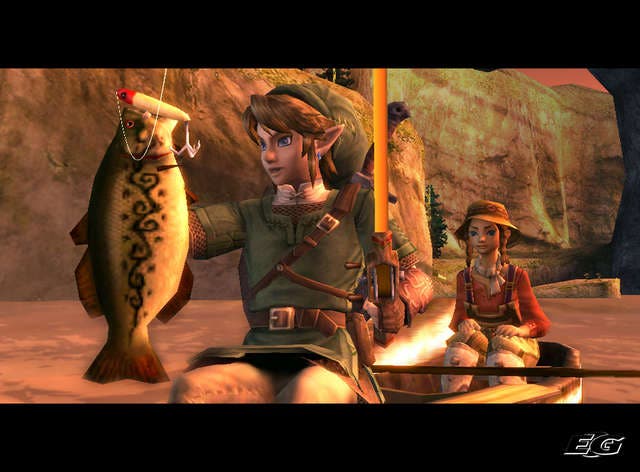
At that point, you become Link again, and venture further into the kingdom to engage in what usually amounts to really engaging platform puzzling with a hefty dose of (ridiculously easy) combat thrown into the mix. Reminiscent of the crafted, cunningly designed early Tomb Raider games, the widescreen vision of Shadow of the Colossus and the masterfully devious Metroid Prime titles, you find yourself slowly chipping away at the task in hand by activating switches, performing timed jumps, collecting essential artefacts, freeing unfortunates and, eventually, meeting fearful, screen-filling bosses. Well, they look fearful to begin with, at least, but are all pretty easy to dispatch thanks to the game's continuation of its rather forgiving (but nevertheless fairly entertaining) combat mechanics.
To begin with you might not be all that impressed with the way Twilight Princess utilises the controller. A lot of the time it feels like the game's 'grunt combat' has been shaped around the Wii controller's novelty value ahead of genuine innovation. For example, you essentially shake the nunchuck to pull off a spin attack, and wobble the Wii remote left and right to pull off a slice - and neither require any real skill or timing whatsoever, which is a bit of a wasted opportunity and will only add weight to the argument that most games simply don't benefit from novelty controllers. It's not made any more impressive as a technical demonstration by the fact that the game allows you to Z-lock-on, flail indiscriminately and still succeed - something that could have been adequately mapped to two buttons on the Wii remote. Making people look like they're having some sort of seizure in front of their screens isn't the way to grow the videogames market, and might make the Cube version more fun in one small respect.
Having said that, Nintendo does make excellent use of the Wii remote's motion sensing ability elsewhere. For example, weapons that require you to aim, such as the slingshot, bow and arrow, the wind-powered Gale boomerang and the claw chain grapple require you physically aim the Wii remote at the screen and target objects and enemies yourself. The sensitivity of such actions means that it does take a bit of getting used to, but it's a novelty that doesn't wear off. To start with it gives you a simple means of firing your slingshot at enemies, but throughout the game new items get added to your arsenal that not only help you solve certain puzzles, but show off the new controller in a better light.


